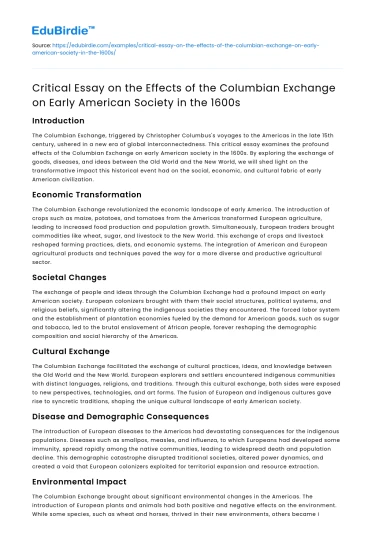Introduction
The Columbian Exchange, triggered by Christopher Columbus's voyages to the Americas in the late 15th century, ushered in a new era of global interconnectedness. This critical essay examines the profound effects of the Columbian Exchange on early American society in the 1600s. By exploring the exchange of goods, diseases, and ideas between the Old World and the New World, we will shed light on the transformative impact this historical event had on the social, economic, and cultural fabric of early American civilization.
Economic Transformation
The Columbian Exchange revolutionized the economic landscape of early America. The introduction of crops such as maize, potatoes, and tomatoes from the Americas transformed European agriculture, leading to increased food production and population growth. Simultaneously, European traders brought commodities like wheat, sugar, and livestock to the New World. This exchange of crops and livestock reshaped farming practices, diets, and economic systems. The integration of American and European agricultural products and techniques paved the way for a more diverse and productive agricultural sector.
Save your time!
We can take care of your essay
- Proper editing and formatting
- Free revision, title page, and bibliography
- Flexible prices and money-back guarantee
Societal Changes
The exchange of people and ideas through the Columbian Exchange had a profound impact on early American society. European colonizers brought with them their social structures, political systems, and religious beliefs, significantly altering the indigenous societies they encountered. The forced labor system and the establishment of plantation economies fueled by the demand for American goods, such as sugar and tobacco, led to the brutal enslavement of African people, forever reshaping the demographic composition and social hierarchy of the Americas.
Cultural Exchange
The Columbian Exchange facilitated the exchange of cultural practices, ideas, and knowledge between the Old World and the New World. European explorers and settlers encountered indigenous communities with distinct languages, religions, and traditions. Through this cultural exchange, both sides were exposed to new perspectives, technologies, and art forms. The fusion of European and indigenous cultures gave rise to syncretic traditions, shaping the unique cultural landscape of early American society.
Disease and Demographic Consequences
The introduction of European diseases to the Americas had devastating consequences for the indigenous populations. Diseases such as smallpox, measles, and influenza, to which Europeans had developed some immunity, spread rapidly among the native communities, leading to widespread death and population decline. This demographic catastrophe disrupted traditional societies, altered power dynamics, and created a void that European colonizers exploited for territorial expansion and resource extraction.
Environmental Impact
The Columbian Exchange brought about significant environmental changes in the Americas. The introduction of European plants and animals had both positive and negative effects on the environment. While some species, such as wheat and horses, thrived in their new environments, others became invasive and disrupted native ecosystems. The extraction of resources, deforestation, and the introduction of new agricultural practices also had long-lasting environmental consequences. The Columbian Exchange marked a turning point in the relationship between humans and the natural world, foreshadowing the environmental challenges that would emerge in later centuries.
Conclusion
The effects of the Columbian Exchange on early American society in the 1600s were far-reaching and transformative. This critical essay has explored the economic, social, cultural, demographic, and environmental impacts of this historic event. The exchange of goods, diseases, and ideas between the Old World and the New World altered the course of history, shaping the trajectory of early American civilization. By critically examining these effects, we gain a deeper understanding of the complexities of colonialism, cultural exchange, and the interconnectedness of global history.






 Stuck on your essay?
Stuck on your essay?

